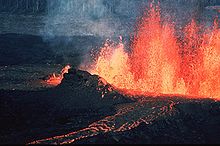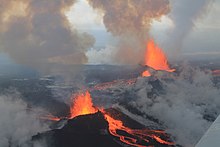
Back Vulkaanskeur Afrikaans بركان تصدعي Arabic Fisura volcánica AST Çat vulkanizmi Azerbaijani Fissura volcànica Catalan Spaltevulkan Danish Spaltenvulkan German Fisura volcánica Spanish Lõhevulkaan Estonian Rakotulivuori Finnish








A fissure vent, also known as a volcanic fissure, eruption fissure or simply a fissure, is a linear volcanic vent through which lava erupts, usually without any explosive activity. The vent is often a few metres wide and may be many kilometres long. Fissure vents can cause large flood basalts which run first in lava channels and later in lava tubes. After some time, the eruption tends to become focused at one or more spatter cones. Small fissure vents may not be easily discernible from the air, but the crater rows (see Laki) or the canyons (see Eldgjá) built up by some of them are.
The dikes that feed fissures reach the surface from depths of a few kilometers and connect them to deeper magma reservoirs, often under volcanic centers. Fissures are usually found in or along rifts and rift zones, such as Iceland and the East African Rift. Fissure vents are often part of the structure of shield volcanoes.[1][2]
- ^ "V. Camp, Dept. of Geologic Sciences, Univ. of San Diego: How volcanoes work. Eruption types. Fissure eruptions". Archived from the original on 2018-02-28. Retrieved 2014-09-24.
- ^ "Geology glossary". www.volcanodiscovery.com. Retrieved September 25, 2001.
© MMXXIII Rich X Search. We shall prevail. All rights reserved. Rich X Search